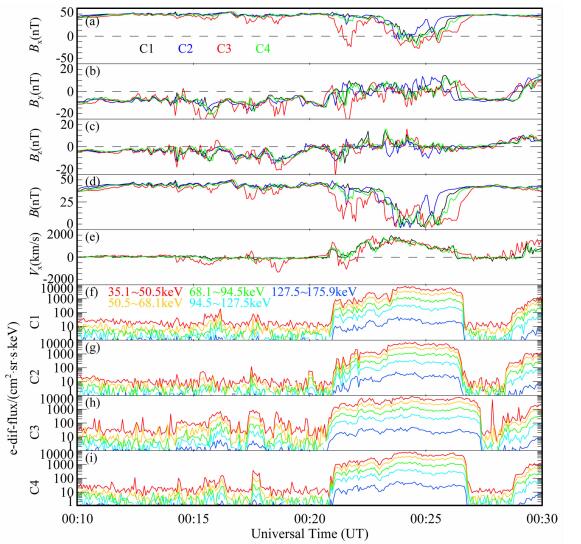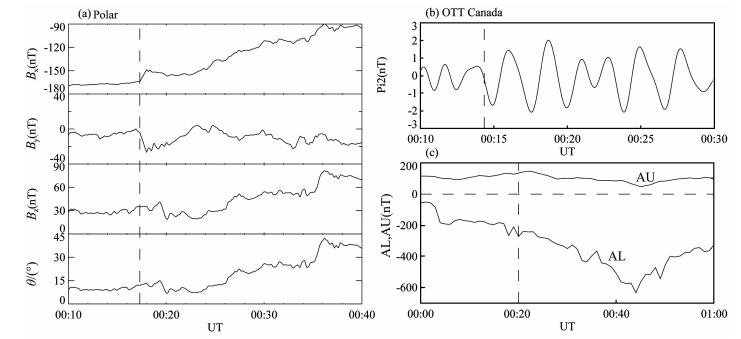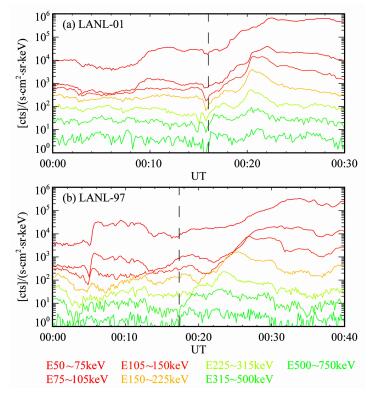2. 中国科学院地质与地球物理研究所, 北京 100029
2. Institute of Geology and Geophysics, Chinese Academy of Sciences, Beijing 100029, China
磁层亚暴是起始于地球夜晚面的一种瞬态过程,在此过程中来自太阳风-磁层耦合的很大一部分能量被释放和储存在极区电离层之中[1].单个亚暴过程一般持续二至三个小时[2, 3].一般认为,当行星际磁场由北转向南之后,太阳风能量通过向阳面磁层顶磁场重联输入磁层,一部分随即在极区通过粒子沉降被释放,而另一部分储存在磁尾[4].亚暴通常包括三个阶段:增长相,膨胀相和恢复相.增长相期间,磁尾积聚大量能量;膨胀相期间磁尾的大量磁能突然释放;当能量减少到一定程度时,恢复相开始.亚暴的根本原因是太阳风向磁层输入能量的急剧增加和随之而来的能量释放,亚暴过程中总是伴随着Pi2脉动的出现,Pi2脉动被认为是亚暴的指示器[5].近来的研究发现,行星际磁场北向时亚暴仍可能发生[6].磁层亚暴过程中,有三个主要观测特征:中磁尾(约20~30 RE)磁场重联,近尾(约6~8 RE)电流片电流中断和电离层极光爆发.磁场重联过程中,磁能转化为等离子体动能和热能,产生地向和尾向高速流;电流中断过程中,越尾电流转向为场向电流、进入电离层,磁场发生偶极化;电离层极光爆发以后,极光卵极向、西向膨胀.
亚暴的触发机制一直是亚暴研究的热点.最具影响的亚暴模型有近地中性线模型和越尾电流中断模型.近地中性线模型认为:中磁尾磁场重联(约20~30 RE)产生高速流,高速流和磁通量地向运动,在近磁尾(约6~8 RE)产生堆积、磁场偶极化.由重联高速流在此处产生的压力梯度导致亚暴电流楔,从而触发亚暴[7].电流中断模型认为[8]:亚暴膨胀相触发是由于近地(约6~8 RE)越尾电流的某种不稳定性.近地这种不稳定性导致电流中断、形成亚暴电流楔,磁场偶极化.偶极化尾向传播,触发中磁尾重联.争论的焦点为中磁尾磁场重联还是近尾电流中断(磁场偶极化)触发亚暴.濮祖荫等提出另一种模型:重联-电流中断协同模型,强调中磁尾重联为亚暴提供足够能量、而近地磁尾气球模不稳定性的发展导致近地电流中断[9, 10].
可见,亚暴过程中主要观测特征的时序研究对于研究亚暴触发机制尤为重要,因为这种时序性能够反映出磁尾物理过程的因果关系[11].联合多颗卫星及地面台站的观测来研究亚暴时序是目前较为常见的方法之一[12, 13].部分观测已经证实中磁尾重联起始时刻早于亚暴起始时刻[12~15],而另一部分观测则发现膨胀相起始后,电流中断(磁场偶极化)尾向传播[16~18].
本文利用Cluster Ⅱ、LANL-01、LANL-97、Polar、IMAGE和加拿大OTT地面台站的观测,分析了2001年9月15号的单个亚暴事例.最先观测到重联在中磁尾(约19 RE)发生,紧接着同步高度附近观测到粒子注入、磁场偶极化过程,最后观测到极区极光亚暴爆发.此处的单个亚暴时序研究支持中磁尾磁场重联触发亚暴.
2 卫星及仪器Cluster Ⅱ[19]是由四颗完全相同的卫星组成的卫星簇,四颗卫星在空间构成四面体结构.本文利用了Cluster卫星携带的FGM[20]仪器的磁场数据、CIS[21]仪器的质子整体流数据及RAPID[22]仪器的高能电子微分通量数据,卫星的旋转时间分辨率是4 s.POLAR卫星提供了近尾磁场数据. LANL-01卫星用来探测同步高度的粒子注入事件,IMAGE卫星多频段成像仪(WIC)[23]探测极光亚暴及加拿大OTT地磁观测台站(285°N,45°E)的磁场观测数据.
3 亚暴事例分析2001年9月15日00:00 UT开始,行星际磁场Bz约为3.81 nT (GES坐标系),太阳风速度Vx约为-458.6 km/s (GSE坐标系),持续近1 h. VxBz参量为负值,太阳风和磁层存在很强的耦合[12].00:00~01:50 UT时间范围内,单个亚暴事例被观测到.亚暴在内磁层的主要特征都被观测到:中磁尾磁场重联、偶极化(电流中断)、粒子注入和极光辉度突然增强[24].多个观测特征的时序关系清楚地说明了重联起始早于极光亚暴起始,约7 min.以下具体分析亚暴过程中各个观测特征.
3.1 中磁尾磁场重联分析2001年9月15日00:10 UT时,Cluster卫星位于磁尾(-18.9,3.5,1.1) RE,C3卫星位于最南侧而C1卫星位于最北侧,四颗卫星形成四面体结构.图 1为00:10~00:30 UT时段内,磁场及等离子体数据图.(a~d)依次代表磁场的三个分量及磁场强度,(e)表示x方向质子高速流,黑色、蓝色、红色和绿色曲线分别表示C1、C2、C3和C4卫星的数据;(f~i)分别表示四颗卫星的高能电子微分通量,不同颜色曲线代表不同的能量范围.在00:14 UT时,Cluster四颗卫星观测到很强的南向磁场(Bz约-15 nT),同时位于最南侧的C3卫星观测到较强的尾向高速流(约500 km/s).强的南向磁场持续到00:21 UT,然后转为北向.此时段内,C3卫星位于最南端(Bx较弱),多次观测到尾向高速流,最高速率达1100 km/s.从00:21 UT开始,C3卫星由中性片北侧穿越中性片至南侧(Bx由正值转变为负值),紧接着又返回中性片北侧.在此穿越过程中,X方向高速流由尾向转变为地向(GSM坐标系).在00:22~00:27 UT时间段,四颗卫星逐渐靠近中性片,观测到持续的地向高速流并伴随着北向磁场,地向高速流速度最大值达1500 km/s.00:27~00:29 UT时间段内,卫星再次远离电流片,高速地向流和高能电子通量峰值消失.此后,随着卫星接近电流片,高速地向流和高能电子通量增强.

|
图 1 00:10~00:30 UT时间段内,Cluster卫星的观测数据 (a~d)依次代表磁场的三个分量及磁场强度,(e)表示x方向质子高速流,黑色、蓝色、红色和绿色曲线分别表示C1、C2、C3和C4卫星的数据;(f~i)分别表示四颗卫星的高能电子微分通量,不同颜色曲线代表不同的能量范围. Fig. 1 The data from the Cluster spacecraft between 00:10 and 00:30 UT (a~b) show three components and magnitude of magneticfield, (e) is x component of proton bulk flow velocity, the black, blue, red and green lines denote the data from C1, C2, C3 and C4, respectively.(f~i) indicate differential fluxes of energetic electrons. Different color lines denote the different energy. |
卫星位于尾瓣区时(00:10~00:14 UT和00:27~00:29 UT),By分量约6 nT,可见此重联为有初始引导场的分量重联.By分量满足Hall四极场特性:Bz磁场南向、Cluster卫星位于中性片北侧(Bx>0)时,观测到By<0;Bz磁场北向、Cluster卫星位于中性片北侧(Bx>0)时,By>0,而位于南侧时,By<0.By的极性变化和粒子模拟及以前的观测研究一致[25~27].
由上面的观测可见,此时段内,Cluster卫星由重联X线尾侧穿越重联区进入重联X线向地一侧.卫星位于重联X线尾侧部分,只有C3卫星观测到高速尾向流,这是由于此时段内其他卫星离中性片较远(Bx约40 nT)所致.虽然其他三颗卫星没有观测到很强的尾向高速流,但由持续的强Bz磁场分量可知,此时段内重联持续进行.故此推断重联起始最迟为00:14 UT.C3靠近中性片过程中(约00:21 UT)观测到短暂的地向高速流,这可能是重联点在X方向振荡所致.
3.2 极光亚暴、偶极化(电流片中断)和粒子注入事件分析图 2为Image卫星的北极光观测图像,观测数据投影在地理经纬坐标系,图中极光辉度由底侧色标定出.图 2a为极光起始时刻,图 2b为亚暴膨胀相阶段,图 2c为对应恢复相.在00:21:03 UT时刻,极光在子夜侧突然增亮,其地理经纬度为(330°N,62°E).此后增亮区向高纬移动,直到00:55 UT时开始减弱.可见极光亚暴膨胀相起始于00:21 UT.

|
图 2 (a)00:21:03 UT;(b)00:45:36 UT;(c)01:10:09 UT. Fig. 2 Aurora images are obtained from IMAGE |
图 3a所示为00:10~00:40 UT时段内,POLAR卫星的磁场观测数据及磁倾角θ(Bz分量与xy平面内磁场矢量的夹角).此时段内POLAR卫星位于(-5.8,-0.3,-2.1) RE(GSM坐标系)附近.约00:17 UT开始(图中竖虚线所示),Bx分量绝对值开始减小,同时Bz的值开始增大.夹角θ逐渐增大,这是典型的磁场偶极化(电流片中断)现象[28],是亚暴在内磁层的主要特征之一[29].

|
图 3 (a) polar卫星观测的磁场数据三分量及磁仰角θ(Bz分量与x-y平面内磁场矢量的夹角);(b)加拿大OTT地磁观测台站Pi2脉动;(c)地磁AU和AL指数 Fig. 3 (a) Three components of magnetic field and them agnetic field elevation angle θ(the angle between Bz and the component of magnetic field in the x-y plane); (b) Pi2 pulse at the OTT observatory of Canada; (c) The indexes of AU and AL |
图 3b所示为位于极光卵增亮区低纬地面地磁台站OTT (285°N,45°E)观测到的Pi2脉动,脉动的起始时刻为00:15 UT.图 3c是00:00~01:00 UT时段内,极光电激流指数AU和AL变化曲线.从00:20 UT时刻开始AL明显减小,在00:44 UT左右,AE指数达到最大值700 nT.AE指数增强的起始时刻约为00:21 UT.
图 4给出了同步轨道附近LANL-01和LANL-97卫星观测到的高能电子通量,不同的颜色表示不同的能量范围,能量范围如图下方所示.此时段内LANL-01位于(-6.5,-1.0,0.2) RE(GSM坐标系)附近,磁地方时(MLT)为00:53;而LANL-97位于(-2.2,-6.2,-0.9) RE(GSM坐标系)附近,磁地方时05:01.00:16 UT,位于子夜附近的LANL-01卫星观测到无色散的高能电子注入事件,大约2 min之后,位于晨侧的LANL-97卫星观测到了一色散的高能电子注入事件.由此可知,高能电子注入在子夜附近,随后东向漂移、逐渐色散.粒子注入的时刻为00:16 UT.

|
图 4 (a)和(b)分别代表LANL-01和LANL-97卫星观测的高能电子计数率,能量范围为50~750keV,不同的颜色曲线代表不同的能量范围 Fig. 4 (a) and (b) represent the count rate of energetic electros from LANL-01 and LANL-97 in energies from 50 to 750keV.Curves with different color denote the different energy range |
上述内磁层各种亚暴特征现象说明:重联最先在磁尾约20 RE处发生,起始时间最迟为00:14 UT;00:17 UT时刻,位于(-5.8,-0.3,-2.1) RE附近的POLAR卫星观测到磁场偶极化(电流中断)开始.几乎同时,同步轨道卫星观测到高能电子注入,且东向漂移;紧接着极区极光增亮,同时伴随着Pi2脉动.
4 讨论及结论利用磁层磁场T96模型[30],将磁尾重联X点的位置沿磁力线投影到北纬极区电离层,得到的X点的足点经纬度分别为(327°N,63°E).此位置和极光增亮点(330°N,62°E)基本重合,可见中磁尾重联和极光增亮直接相关.近来,Segree等提出重联分离线直接延伸至电离层,重联过程中被加速的电子通过分离线沉降到电离层,形成极光,但这一猜想有待进一步的验证[31].
IMF南向时,太阳风能量进入磁层,磁尾积蓄大量能量.当00:14 UT时,重联起始于磁尾-18.9 RE,磁能转化为等离子体动能和热能,高速流地向移动;当00:16 UT时,同步轨道附近(磁尾-6.5 RE),LANL-01卫星观测到高能粒子注入,同时高能粒子东向漂移,2 min之后位于晨侧同步轨道附近的LANL-97卫星观测到粒子注入;00:21 UT时,极区极光活动增强.从磁尾重联和亚暴的时序可以看出,重联起始先于亚暴起始7 min.观测支持中磁尾磁场重联触发亚暴,和近地中性线模型较为一致.
致谢CLUSTER卫星数据来源于CAA.感谢欧空局和FGM、CIS及RAPID仪器工作组提供的数据,日本WDC-C2 KYOTO AE index service提供的AE指数数据,美国NASA的Goddard Space Flight Center提供的行星际条件数据和极光数据,CDAWEB的IMAGE数据图.
| [1] | Kamide Y, Baumjohann W, Daglis I A, et al. Current understanding of magnetic storms: Storm-substorm relationships. Geophys. Re. , 1998, 103(A8): 17705-17728. DOI:10.1029/98JA01426 |
| [2] | 刘振兴. 太空物理学. 哈尔滨: 哈尔滨工业大学出版社, 2005 . Liu Z X. Space Physics (in Chinese). Harbin: Harbin Institute of Technology Press, 2005 . |
| [3] | 曹晋滨, 李磊, 吴季. 太空物理学导论. 北京: 学出版社, 2001 . Cao J B, Li L, Wu J. The Introduction of SpacePhysics (in Chinese). Beijing: Science Press, 2001 . |
| [4] | Gonzalez W D, Joselyn J A, Kamide Y, et al. What is a geomagnetic storm. Geophys. Res. , 1994, 99(A4): 5771-5792. DOI:10.1029/93JA02867 |
| [5] | 徐文耀. 地磁学. 北京: 地震出版社, 2003 . Xu W Y. Geomagnetism (in Chinese). Beijing: Seismological Press, 2003 . |
| [6] | Du A M, Tsurutani B T, Sun W. Anomalous geomagnetic storm of 21-22 January 2005: A storm main phase during northward IMFs. Geophys. Res. , 2008, 113: 10214. |
| [7] | Baker D N, Pulkkinen T I, Angelopoulos V, et al. Neutral line model of substorms: Past results and present view. Geophys. Res. , 1996, 101: 12975-13010. DOI:10.1029/95JA03753 |
| [8] | Lui A T Y. Current disruption in the Earth's magnetosphere: Observations and models. Geophys. Res. , 1996, 101: 13067-13088. DOI:10.1029/96JA00079 |
| [9] | Pu Z Y, Korth A, Chen Z X, et al. , MHD drift ballooning instability near the inner edge of the near Earth plasma sheet and its application to substorm onset. Geophys. Res. , 1997, 102(A7): 14397-14406. DOI:10.1029/97JA00772 |
| [10] | Pu Z Y, Kang K B, Korth A, et al. Ballooning instability in the presence of a plasma flow: a synthesis of tail reconnection and current disruption models for the initiation of substorms. Geophys. Res. , 1999, 104(A5): 10235-10248. DOI:10.1029/1998JA900104 |
| [11] | 张辉, 濮祖荫, 曹馨, 等. 尾瓣持续磁重联与磁层亚暴相关性研究. 科学通报 , 2006, 51(4): 459–468. Zhang H, Pu Z Y, Cao X, et al. Correlation between continuous lobe reconnection in the mid magnetotail and substrom. Chinese Sci. Bull. (in Chinese) , 2006, 51(4): 459-468. |
| [12] | Baker D N, Peterso W K, Eriksson S, et al. Timing of magnetic reconnection initiation during a global magnetospheric substorm onset. Geophys. Res. Lett. , 2002, 29(24): 2190. |
| [13] | Angelopoulos V, Mcfadden J P, Larson D, et al. Tail reconnection triggering substorm onset. Science , 2008, 321(5891): 931-935. DOI:10.1126/science.1160495 |
| [14] | Ohtani S, Creutzberg F, Mukai T, et al. Substorm onset timing: The December 31 1995 event. Geophys. Res. , 1999, 104(A10): 22713-22727. DOI:10.1029/1999JA900209 |
| [15] | Cao X, Pu Z Y, Zhang H, et al. Multispacecraft and ground based observations of substorm timing and activations: Two case studies. Geophys. Res. , 2008, 113: A07S25. |
| [16] | Jacquey C J, Sauvaud A, Dandouras J. Location and propagation of the magnetotail current disruption during substorm onset: Analysis and simulation of an ISEE multionset event. Geophys. Res. Lett. , 1991, 18: 389-392. DOI:10.1029/90GL02789 |
| [17] | Jacquey C, Sauvaud J A, Dandouras I, Korth A. Tail ward propagating cross-tail current disruption and dynamics of near-Earth tail: A multi-point measurement analysis. Geophys. Res. Lett. , 1993, 20: 983-986. DOI:10.1029/93GL00072 |
| [18] | Lui A T Y. Comment on " Tail Reconnection Triggering Substorm Onset". Science , 2009, 324(5933): 1391. |
| [19] | Escoubet C P, Fehringer M, Goldstein M L. The Cluster mission. Ann. Geophys. , 2001, 19: 1197-1200. DOI:10.5194/angeo-19-1197-2001 |
| [20] | Balogh A, Carr C M, Acuna M H, et al. The Cluster magnetic field investigation: overview of in-flight performance and initial results. Ann. Geophys. , 2001, 19: 1207-1217. DOI:10.5194/angeo-19-1207-2001 |
| [21] | Rème H, Aoustin C, Bosqued J M, et al. First multispacecraft ion measurements in and near the Earth' s magnetosphere with the identical Cluster ion spectrometry (CIS) experiment. Ann. Geophys. , 2001, 19: 1303. DOI:10.5194/angeo-19-1303-2001 |
| [22] | Wilken B, Daly P W, Mall U, et al. RAPID the Imaging Energetic Particle Spectrometer on CLUSTER. Space Sci. Rev. , 1997, 79: 399. DOI:10.1023/A:1004994202296 |
| [23] | Mende S B, Heetderks H, Frey H U, et al. Far ultraviolet imaging from the IMAGE spacecraft: 2, Wideband FUV imaging. Space Sci. Re. , 2000, 91: 271-285. DOI:10.1023/A:1005227915363 |
| [24] | Baker D N, Pulkkinen T I, Angelopoulos V, et al. Neutral line model of substorms: Past results and present view. Geophys. Res. , 1996, 101(12): 975-13010. |
| [25] | Fu X R, Lu Q M, Wang S. The process of electron acceleration during collisionless magnetic reconnection. Phys. Plasma , 2006, 13: 012309. DOI:10.1063/1.2164808 |
| [26] | Wang R, Lu Q, Huang C, Wang S. Multispacecraft observation of electron pitch-angle distributions in magnetotail reconnection. Geophys. Res. , 2010, 115: A01209. |
| [27] | Ge Y S, Russell C T. Polar survey of magnetic field in near tail: Reconnection rare inside 9 RE. Geophys. Res. Lett. , 2006, 33: L02101. |
| [28] | Lui A T Y, Liou K, Nose M, et al. Near-Earth dipolarization :evidence for a non-MHD process. Geophys. Res. Lett. , 1999, 26(19): 2905-2908. DOI:10.1029/1999GL003620 |
| [29] | Baumjohann W, Hesse M, Kokubun S, et al. Substorm dipolarization and recovery. Geophys. Res. , 1999, 104(A11): 24995-25000. DOI:10.1029/1999JA900282 |
| [30] | Tsyganenko N A. Modeling the Earth' s magnetospheric magnetic field confined within a realistic magnetopause. Geophys. Res. , 1995, 100: 5599-5612. DOI:10.1029/94JA03193 |
| [31] | Sergeev V, Semenov V, Kubyshkina M, et al. Observation of repeated intense near-Earth reconnection on closed field lines with Cluster, Double Star, and other spacecraft. Geophys. Res. Lett. , 2007, 34: L02103. |
 2010, Vol. 53
2010, Vol. 53


